Cookieless Future is Near, AdTech Looks Forward with AI
PUBLISH DATE: 19 July 2022
The whole adtech industry will soon be impacted by Google’s new “reject all” cookie option. For 50% of Europe, ad tech will soon lose awareness; soon, the same will be true for the US. It is not a theory.
Programmatic advertising and the adtech that supports it ceases to function when a customer clicks “reject all.” When given the option, more than half of iOS users on mobile have chosen not to be tracked by apps or marketers who use Apple’s ATT. The implementation of the reject-all policy has already led to a 55 percent opt-out rate for some publishers in Europe.
The actions taken by companies like Google and Apple to comply with user permission and privacy laws set a new standard. Additionally, privacy and user consent requirements will be implemented in the US, exactly as we saw with GDPR.
Adtech will be forced by this regulatory tsunami to develop into a responsible ecosystem where monitoring and enforcing user permission at a specific data level will be necessary. However, it’s easier than it sounds.
Putting User Consent First
Publishers, who are the proprietors of user consent, will need to take into account the qualifications of their ad tech partners since they will now be required to obtain user approval for each of them. As publishers become stricter and regulations tighten, the effect will be a significantly falling supply chain. Although the audience will still exist, ad tech solutions will be necessary to deliver an ad without processing user data due to the way people are identified—with contextual and first-party signals. And some people already commit errors. It will be necessary for Meta to redesign from scratch in order to comply with the facts revealed by the most recent Meta breach, which implies that their advertising business is not compliant with current and impending privacy standards. User consent is in the hands of premium publishers, but it will need to be exercised. To increase user consent rates and safety, they will need to shorten their supply chain, invest in ad technology that processes data rather than controls it, and provide an advertising solution that operates without user approval.
The Decision to Lead
A transition from accessible towards a more relevant and accountable online is already apparent. Publishers and advertisers may ethically engage audiences when they begin to see ad tech as a facilitator rather than a middleman. Because publisher data can no longer be used to target people outside of their own properties, it may create an ecosystem where its value rises. Transparency in the supply chain is the outcome. Publisher data serves as the ad tech ecosystem’s building block. Publishers should appreciate the value of the first-party data and contextual insights they have to provide and inform advertisers of the legal and ethical options available.
It is about Consent, Not Cookies
User consent will be key in the next phase of advertising technology. Both Meta and Google have acknowledged this. Google has responded to it. And because of a stolen paper, we also know Meta is. Third-party cookies are just one aspect of the disruption of today. The topic is consumer privacy. Because of this, the popularity of “opt-out” and “reject all” will have both a short-term and long-term effect. And the adtech sector ought to start getting ready right away.
Adtech Setting a Benchmark for Future Generation
PUBLISH DATE: 19 July 2022
Adtech has become a booming name in the Tech Ecosystem. Through its tremendous transformation, it has created a buzz that is going to last for years to come. For brands too, there has never been a better time to leverage their ads through digital advertising. The golden era of tech space is just around the corner with the 5G spectrum. With the help of contextual targeting tools and enhanced storytelling, the brands are able to reach millions of audiences and introduce their new products or services. For instance, Foodpanda’s ad received more than five million views on OTT platforms, and British Airways’ famous “Fueled by Love” has been viewed more than 10 million times on the most popular video streaming platform – YouTube.
Forecast data recently updated that it is expected that ad spending worldwide is likely to reach $691 billion by the end of 2023. With the advanced technology, it has become easier for brands to optimize the marketing approach to reach relevant audiences and gain insights about changing user behavior to achieve maximum impact.
Most organizations have already switched to digital strategies for effective marketing. In fact, it has been observed that companies who are still following the traditional method of advertising are missing out on several opportunities to grow.
In fact, a year when total ad spends plummeted by 17%, investments in digital ads snowballed by around 15 percent, clearly depicting where the tradition and digital advertising are at.
A recent report by Dentsu revealed that digital ad budgets is most likely to touch the level of TV by the end of 2022, which however could not have happened without pandemic. A moment like could be most likely to happen by 2025 if pandemic was out of the picture. Undoubtedly, adtech has great potential and it has already directly impacted the way the audience is interacting with the sponsored content.
Given the scenario that online user behavior is constantly changing, adtech will continue to dictate how content is marketed online.
Contextual Intelligence: Everything You Need to Know and Why It Matters
PUBLISH DATE: 14 July 2022
Contextual intelligence is not an unheard term for the advertising industry, rather marketers have been knowing it for many years. What is happening now is that this form of advertising is undergoing a resurgence.
As users’ privacy concerns and brand safety woes continue to grow, marketers are seeking an ad targeting solution that does not make use of user data, provides impressive results, and at the same time, does not damage brand reputation. Such a solution is offered by contextual advertising, which involves the use of contextual intelligence for placing ads next to contextually relevant content only, thereby making ads interesting to consumers.
How Contextual Targeting Works?
In the realm of digital advertising, contextual advertising, also known as contextual ad targeting, makes use of contextual intelligence to deliver ads based on the content being viewed by users. It does not take into consideration who is viewing the content; its focus is just on the content itself. By comprehending what’s on a web page, contextual targeting communicates a brand’s message that is contextually relevant, and therefore, has a greater chance of driving action.
The major difference between contextual advertising and behavioral advertising is that context-based advertising uses a webpage’s content instead of data provided by third-party cookies to serve ads. Third-party cookies track the personal data of users, thus leading to data privacy issues.
An example that can be cited here is an airline company that wants to target people planning vacations. In order to reach the right people in the right context, it will display ads on web pages with content about destinations for vacation, resorts, hotels, beaches, etc. This contextual advertising campaign will enable the airline to reach a relevant audience. In order to ensure brand safety and suitability, the campaign will avoid ad placement against content related to natural calamities such as hurricanes, storms, tornadoes, etc.
Advantages of Contextual Intelligence for Advertisers
Contextual intelligence offers many advantages to digital advertisers as discussed below:
1. Compliance with Data Privacy Regulations
Contextual intelligence enables marketers to deliver ads without using the personal data of users. Thus, contextual targeting is fully compliant with data privacy laws such as the GDPR and the California Consumer Privacy Act (CCPA).
2. Reach Maximum Audience
Advertising campaigns powered by AI-based contextual advertising technology are able to reach the maximum audience. This is because artificial intelligence and machine learning algorithms allow precise targeting of a maximum number of contextually relevant web pages.
3. Increase Consumer Engagement
As contextual intelligence enables delivering ads that align with the content that people are engaging with, it leads to increased consumer engagement with the ads. The increased engagement results in a higher chance of people clicking on the ad and reaching the product web page on the brand’s website. This ultimately leads to increased sales.
4. Ensure a Brand Safe and Suitable Environment
Contextual intelligence helps brands place their ads in a safe and suitable environment. It allows brands to take into consideration the socio-cultural trends so that their messages do not appear against inappropriate content. In the world of programmatic advertising, brands do not have control over where their ads will be placed. By adopting AI-powered contextual advertising solutions, brands can prevent negative associations.
6 New Google Ads Updates You can’t Miss to Check out in 2022
PUBLISH DATE: 11 July 2022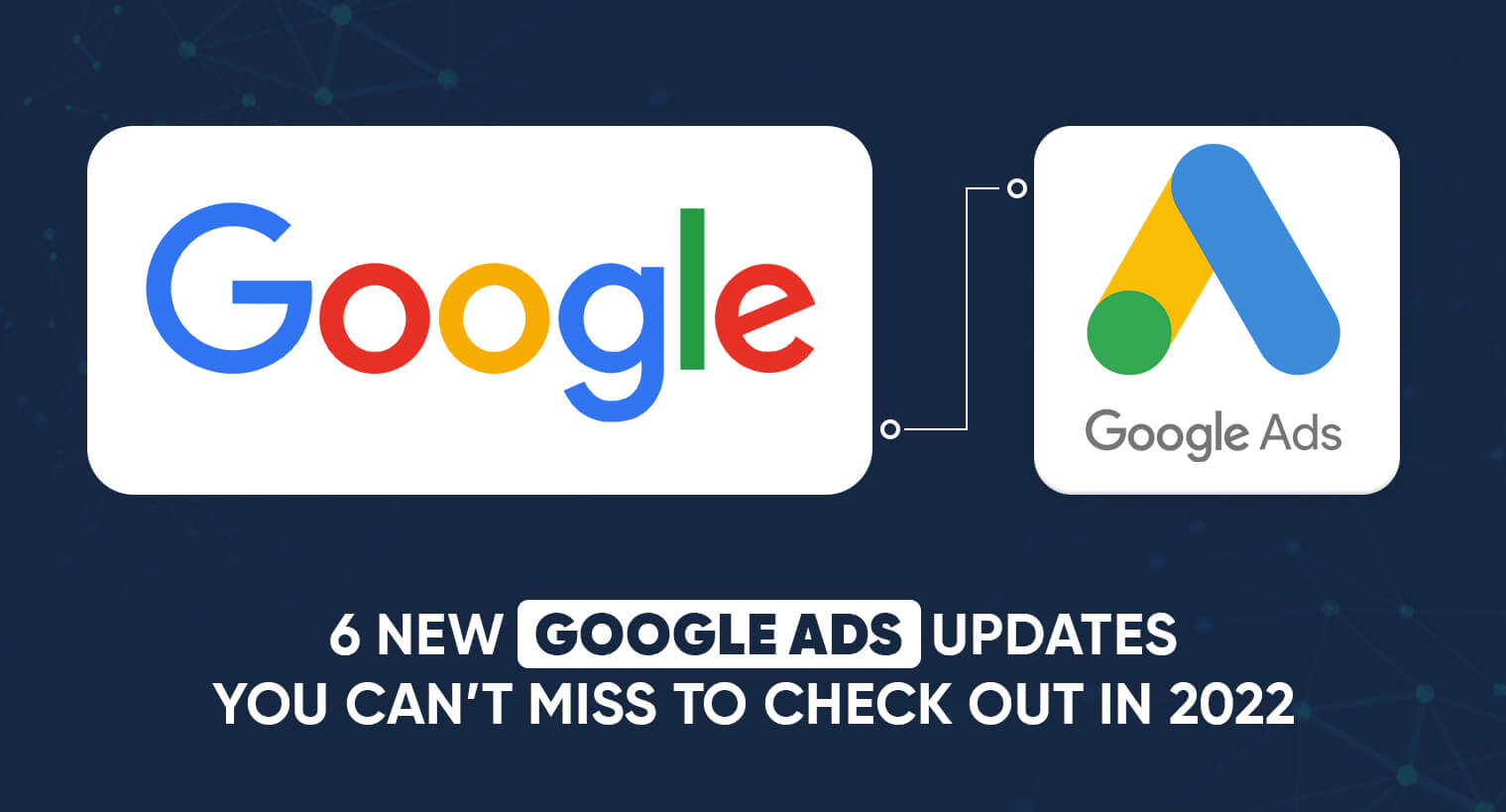
Google is about to launch and upgrade its Google Ads feature. Excited to know what exactly those are? Let’s dig right in.
Google Ads updates are progressively moving to automate many parts of its mind-boggling machine. Bidding, Targeting, other small parts of the advertisement text experience are either fully or partly automated.
Ad expansions will offer more data about your business and make it really easier to draw in more engagements. Perhaps, marketers can see a 20% increase in clickthrough rate when almost four site links show with their Google ad settings.
Google is offering various features to help you publish engaging ads. It will make site links, callouts, and structured snippets easier. Are you excited? So are we!
6 New Google Ads Updates That you Must Know
-
Engage More Individuals with Automated Extensions

Google automated extensions gives advertisers more robust ads and chances to win new customers. For example, if automated extensions are predicted to improve your ad’s performance, Google Ad Manager will create new extensions on your behalf and present them with your ad.
Earlier, site links, structured snippets, and callouts weren’t capable of showing your ad if you provided manually created site links, snippets, and callouts.
From mid-march onwards, these extensions will be able to present their manually-created counterparts.
For instance, if your Google Ad has only two manually-generated site links accessible, Google Ads can offer two site links simultaneously, showing your ad with four site links.
With this update, you’ll have the option to see reporting for these automated extensions at a personal level on the Extensions page. After reviewing, you can remove or pause each extension. It will simplify managing the extensions that google creates on your behalf.
To see which automated extensions are visible with your Google Ad settings, search for “Automatically created” extensions in the table view of the page (extension).
-
Google Merchant Center launched an Option of Short Title

Now sellers can add a short title to identify their product in Google Merchant Center.
Advertisers can now optimize their product titles to a new level with Google Merchant Center’s newly added feature. The short title should be concise and written to show in “browsy experiences,” like Discovery campaigns and Shopping advertisements on Gmail.
This allows you to be more precise and on point with your products. Generally, it has been observed that full product titles get trimmed in the “browsy” ad settings. This implies that users may not be viewing all the relevant data from your ad. Short titles offer sellers a fast method for distinguishing their products, which could help with improving clickthrough rates.
Best practices for short titles. Google ad suggests restricting your short titles to 65 characters or less because customers usually see the initial 65 characters of a short title (contingent upon their screen size).
-
New Google Shopping Experience Scorecard

Merchant Center helps the advertisers to manage in-store and online product inventory appears on Google.
Google is informing the merchants who use the Google Merchant Center about a new feature called Shopping experience scorecard. It can be used to boost rankings in Google Shopping, in addition with other benefits. In short, if you provide an “excellent customer experience”, Google will reward you.
Google will remunerate you with “a badge,” “a raise in rankings,” and “different advantages that will help buyers with finding your business,” inside the Google Shopping tab in Google Search.
To review your performance and score:
- Sign in(Google ads login) to your Merchant Center account.
- From the navigation menu, click on Growth.
- Click on the Shopping experience scorecard.
Suppose you are a merchant and part of Google Merchant Center and think you can give that level of “excellent” client service. In that case, you should share these metrics with Google Ad Manager because it will help you gain better visibility in Google Shopping.
-
Track Down more Opportunities with Recommendations
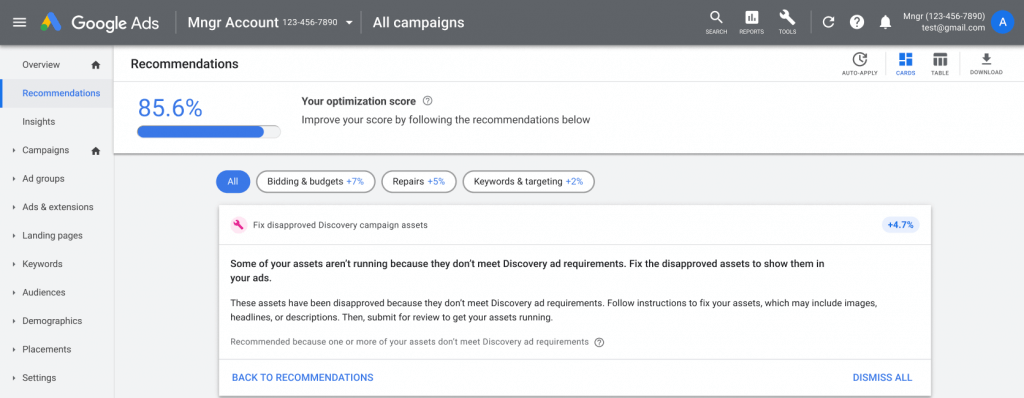
Recommendations can assist you with polishing your performance by analyzing your account’s campaign setting, performance history, latest trends, etc. Advertisers who used recommendations to boost their account level optimization score saw around a 14% increase in conversion.
To help you discover more opportunities in your Google ad settings, Google adds new recommendations and tools. Now you can use recommendations and polish your video campaigns.
-
Test Easily on a New Experimental Page
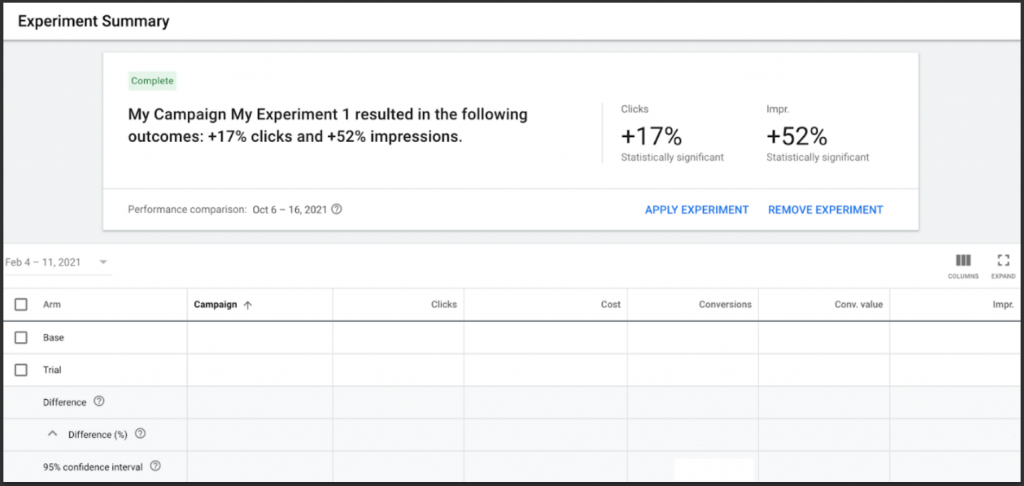
In today’s constantly changing environment, it has become increasingly essential for businesses to move with rigorous, data-driven testing.
So the best way to do this in Google Ads is by running experiments, which makes it even easier for you to test in your account.
In this new feature, advertisers can now create, manage, and optimize all their experiments in one place.
-
Changes in Keyword Matching Behavior
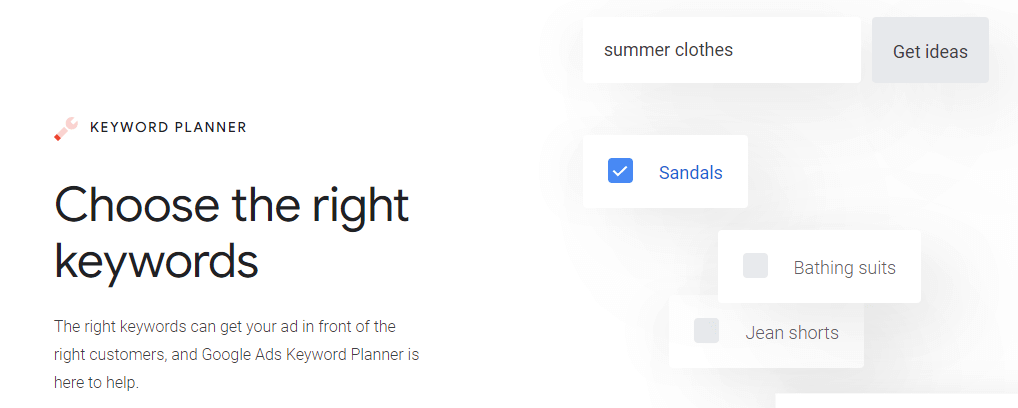
Let’s talk about keyword search! Again one of the essential tools to understand the target audience and their queries are mapping them by keyword search.
Here are the two advantages that keyword search does in the case of google ads –
- Ads will now prefer broad match and phrase match keywords identical to a query without an exact match keyword.
- If you have different match types for a keyword-relevant to a query but not exact, Google will not decide based entirely on Ad Rank but relevancy (thanks to BERT).
To sum up, Google Announcements constantly provides all its users with regular updates and helps in improving their browsing experience of all sorts. Why should your business be left behind?
In-Game Advertising: Is this the New Advertising Format for Digital Advertisers?
PUBLISH DATE: 11 July 2022
In-game advertising (IGA) is frequently similar to the advertisements we see in real life, despite the impression that video games are separated from reality. The most common types of advertisements we see outdoors are billboards, posters, and logos displayed on boards at sporting events, but the popularity of in-game advertising is bringing these types of advertisements to well-known video games.
In-game advertising includes banners, video commercials, audio adverts, and minigames that promote a specific brand in computer, mobile, or console games (IGA). Static advertisements, dynamic ads, and game advertising are the three most prevalent IGA types.
The industry for in-game advertising is expanding quickly. The sector is anticipated to be valued at $56 billion USD at the end of 2024. This number is followed by a broad range of advantages. The most significant economic benefits that in-game advertising offers are tied to revenue, engagement, and connection with the right audience.
Advertisers are eager to use formats that are valuable to and encourage engagement with their target audience. You’ll most likely see the following ad styles while playing video games:
Rewarded Video: By watching a full-screen, typically unskippable video ad, a player may receive in-game incentives.
Interstitial Ad: After finishing a level or other in-game task, a full-screen, clickable advertisement with a call-to-action button appears.
Display Banners: These advertisements appear at the top or bottom of the game’s screen and might be static or dynamic.
Playable Advertisements: While playing another game, a playable demo of another game may display.
Offerwall: It is a virtual platform that offers a variety of tasks, such as software installations, survey responses, and game challenges.
Coupon Advertisements: A gamer may obtain a special coupon or discounts for offline purchases.
Advertisers can target a certain group of gamers through in-game advertising (IGA). The three IGA ad formats that advertisers can use to advertise their goods inside well-known video games are dynamic in-game ads, static in-game ads, and game advertising.
A successful marketing campaign can boost income for the advertiser, get players to engage with the brand, and target audiences that will respond well to the promos.
Silverpush Wins Big at MMA Smarties MENA 2021 Awards
PUBLISH DATE: 30 June 2022Silverpush, a Singapore-based marketing solutions provider which offers AI-based solutions won big at MMA Smarties MENA 2021 awards. The AI-based ad tech firm won 3 Gold awards for the RAKBank – EMO-BOT campaign and other awards in different categories and campaigns. It was a proud moment for the Silverpush team across the globe as they once again proved they are the unbeatable when it comes to contextually-relevant video advertising.
Silverpush is an advertisement technology company that leverages technologies like deep learning and computer vision to help advertisers reach their targeted audience at the moment it matters most. Its two main products- Mirrors and Parallels have made their mark in the advertising industry by helping brands reach their audience at the correct time and place contextually.
RAKBank – EMO-BOT- Emotional Robot, and Kitco IPL Sports Sync AI Activation were the two campaigns for which Silverpush bagged six awards in total. The six category awards in different campaigns for which Silverpush got the awards are these –
Campaign Name – RAKBank – EMO-BOT- Emotional Robot:
- Gold – Machine Learning and AI
- Gold – Lead Generation / Direct Response / Conversions
- Gold – Data/Insights
- Bronze -Contextual / Native Advertising
Campaign Name – Kitco IPL Sports Sync AI Activation:
1) Silver – Machine Learning and AI
2) Silver – Innovation

Silverpush was honored with Gold for its EMO-BOT campaign with RAKBANK. The bank had partnered with MetLife to sell life insurance to people in the UAE. Unlike chips or a car, life insurances are a tricky product to sell, and research suggested that life insurances are purely emotions based. Thus, to sell life insurance to people who aren’t even looking for it or strike the right emotional chord with people, RAKBANK joined hands with Silverpush.
Its AI-powered EMO-BOT has the power to detect unquantifiable human emotions. The bot scanned through the YouTube inventory and filtered out videos that were relevant to the 75+ life stages detected. By deploying a range of contextually relevant ads for each stage the gap between video content, the ads message, and the viewers’ emotions were bridged. The campaign was successful in achieving 2 million+ impressions, reaching 4,51,000 audiences and the engagement rate was 1.5X higher than the average benchmark and the company was able to sell insurances worth $350k.
The next in line is the Kitco IPL Sports Sync AI Activation campaign that gave Silverpush two (02) silver and one (01) bronze award in the MMA event. Cricket is not just a game but an emotion for Asians and the company aimed to become their number one snack during game time. For this, the savory snack company partnered with Silverpush to leverage the authentic fan emotions and passions to reach the Asian fans in the UAE during IPL. Silverpush’s AI-based sports sync technology helped KITCO chips bridge the emotional gap between cricket fans and engagement and capitalize on the munching habit of fans during in-game moments. The campaign was successful in gathering 5 million+ impressions, 1.92 million views, and 1.81+ unique users.
Silverpush is re-engineering the future of the advertising industry with its artificial intelligence-powered advertising technology solutions. Its robust ad tech solutions help brands in connecting with consumers at the right time and place and thus boost brand awareness, conversions, and sales.
Mapping the Future of Advertising Technology Worldwide
PUBLISH DATE: 29 June 2022
The phrase “advertising technology,” or “adtech,” refers to a broad category of hardware and software used by marketers to deliver and track their digital advertising campaigns and target audiences. Adtech emerged to simplify the process as buying and selling online ads got increasingly difficult.
Demand-side platforms are popular ad tech products that let advertisers buy impressions and choose audiences across a variety of publisher websites. Advertisers and agencies may now manage integrated campaigns successfully thanks to adtech. Additionally, it enables businesses to maximize their return on investment (ROI) from digital advertising and make the best use of their budget. In the end, the ad tech landscape gives advertisers the ability to work towards a common plan and enhance their marketing initiatives.
By the end of the decade, biometric data is projected to be a significant part of consumer identification information, necessitating the establishment of corporate strategies and policies that can secure its use. To fulfill the requirements of post-Millennial generations over the next ten years, businesses will need to become more open, environmentally friendly, and purpose-driven. As the 10-year deadline set by the UN to escape the worst effects of climate change approaches, for instance, experts expect this audience will make environmental issues a key component in consumer decision-making.
Consumers are more likely to engage with brands that advertise next to legitimate content, less willing to indulge with companies that advertise next to false, objectionable, or inflammatory content. Only 17 percent of today’s buyers’ and sellers’ inventory is used programmatically. That will nearly double in two years.
Marketers may identify patterns and foresee them with AI technology. On the basis of these statistics, they can decide how to distribute their expenditures and who they should focus on. Brands can spend less money (and effort) on ineffective digital advertising and more time on tasks that are of high value.
How does Programmatic Targeting help Improve your Business?
PUBLISH DATE: 09 June 2022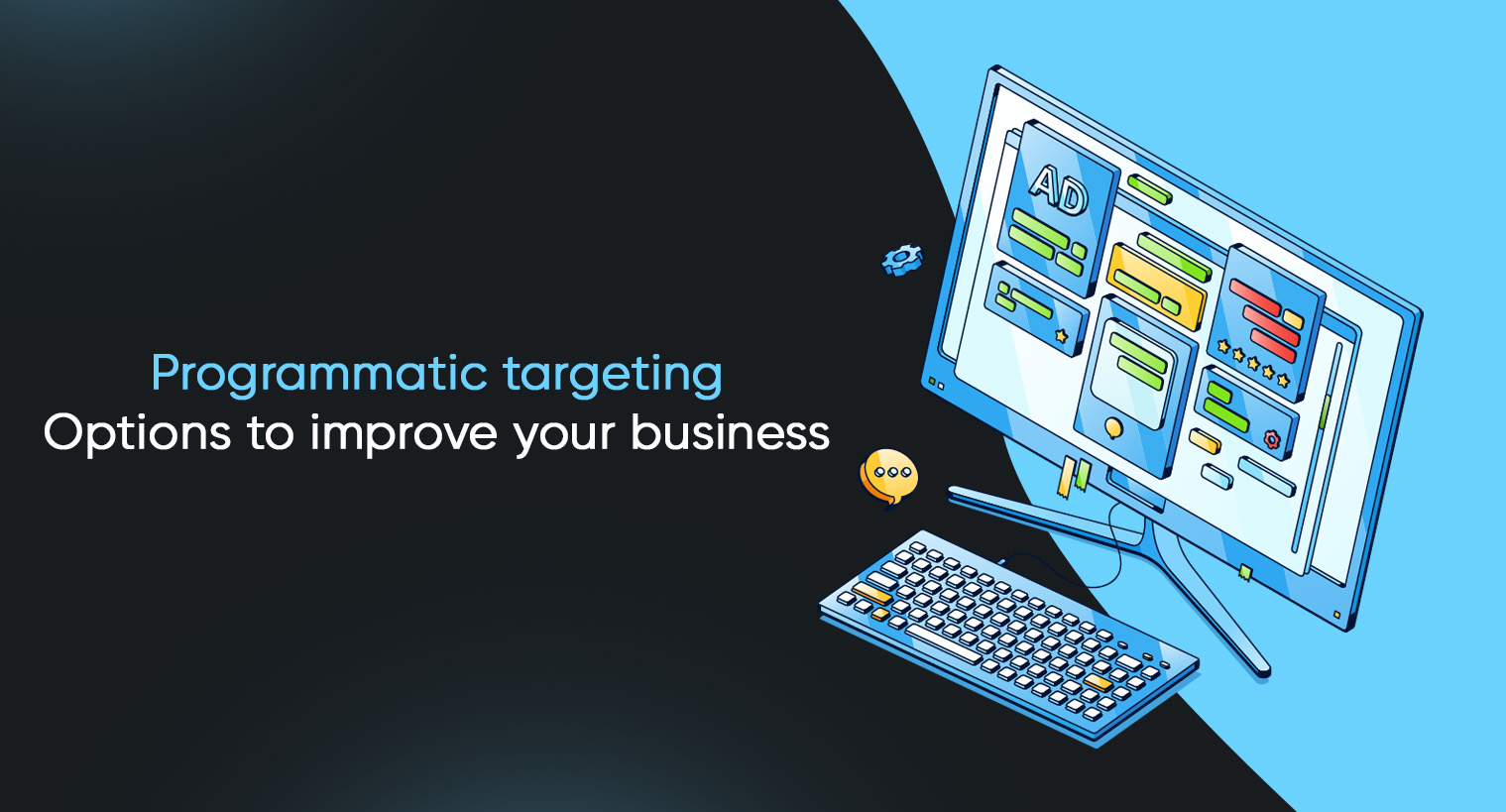
There are several advantages of programmatic targeting due to which it is the first choice of advertisers. However, it is the least understood marketing strategy. Wouldn’t it be great if you are able to promote your business to thousands of customers without breaking bank? Well, you can do this exactly with programmatic advertising.
This cutting edge technology allows business to reap the benefits of artificial intelligence to optimize ad placement and targeting the audience in the best possible way.
According to a prediction by Emarketer, US programmatic digital display ad expenditure will reach over $133 billion by 2023. Moreover, the growth, this year will be increased by 29% as compared to the previous year. In addition to this, Statista also stated that programmatic advertising is one of the leading methods for buying and selling ads in the digital sphere.
What is Programmatic Targeting?
It is critical in business to keep up with the current developments, the most important of which is programmatic advertising. It is a type of advertising that allows you to target your audience more efficiently and successfully. Since programmatic advertising is based on an algorithm, it automates the purchasing and selling of advertisements. This means it may modify the timings, placements, ad variations, bid changes, and other elements of your ad in real-time.
It is extremely beneficial for business owners since they will no longer have to manually update or check their campaign settings at all hours of the day.
The AI that drives programmatic advertisements will rapidly assess your ads and make the required modifications to guarantee they run smoothly and automatically. This means you don’t need to squander any more money and can only spend what is necessary to communicate your message to the audience and get the leads you need.
Programmatic Targeting Helps Improve the Working of Functioning
According to reports, programmatic ads accounts for 72% of all digital display advertising spend. This demonstrates that now is the best time to begin using programmatic advertising for your business.
The key reason that programmatic advertising is leading the digital display business is that it does not require face-to-face discussions. Several other advantages may be provided to both advertising and publishers. Let us look at a couple of them:
- Data is Available in Real-Time
Real-time insights on campaign success are provided via programmatic display advertising. So, advertisers no longer have to wait for the outcomes of their initiatives. Real-time data and high-quality reporting enable campaigns to be optimized more quickly and efficiently.
- Relevant Targeting
Programmatic advertising saves on ad wastage since it aims at only the relevant audience and not the ones that aren’t your target.
It appears that addressing them to a certain group of individuals who will be interested in the shown advertising is a wiser strategy. Programmatic targeting allows you to target the proper audience, which is critical for effective advertising.
- Better and Increased Efficiency
Since programmatic ads automates the process, it can enhance the efficiency of your media purchase. This is done by decreasing the need for manual optimization, you may save time and money.
- Higher ROI
By allowing you to focus your money on the most successful placements, programmatic advertising can help you achieve a higher return on investment (ROI).
- Enhanced Reach
With programmatic targeting, you may reach a huge audience with your ad campaigns. This is because programmatic advertising is not tied to a single site or network.
What are the Popular Programmatic Options for Businesses?
The most intriguing aspect of programmatic targeting is that there are several alternatives to select from, and the majority of them may be utilized concurrently to reach a larger audience. Every programmatic targeting approach enables the attainment of online advertising goals more quickly and at a lower cost.
The following are some of the most popular programmatic targeting options:
- Targeting Demographically
When attempting to reach your target audience, it is best, to begin with, the fundamentals. You aim to reach middle-aged guys in this situation. Demographic targeting will assist you in locating the appropriate individuals depending on their age, gender, ethnicity, and education.
- Geo-Targeting
Geotargeting assists in locating a certain set of audiences. Every device has an IP address that is allocated to a certain area, city, or country, which is why you know who will be interested in your items and where they will be interested. Users’ whereabouts are provided by Internet devices based on the network they use to search online.
- Data Targeting
You may get the greatest results from your programmatic advertisements by using user data. You may pick between three types of data: first-party data, second-party data, and third-party data.
Final Words
Through automated selling and purchase of advertising spaces, programmatic advertising enables firms to reach their target audiences more effectively.
It is a more convenient choice for businesses because it is faster and does not require in-person negotiations.
Moreover, it lets you reach the correct audience through a variety of programmatic targeting choices. That is why it is gaining popularity in the advertising sector and will continue to do so.
How to Use Contextual Targeting in CTV, OTT, and Online Video?
PUBLISH DATE: 08 June 2022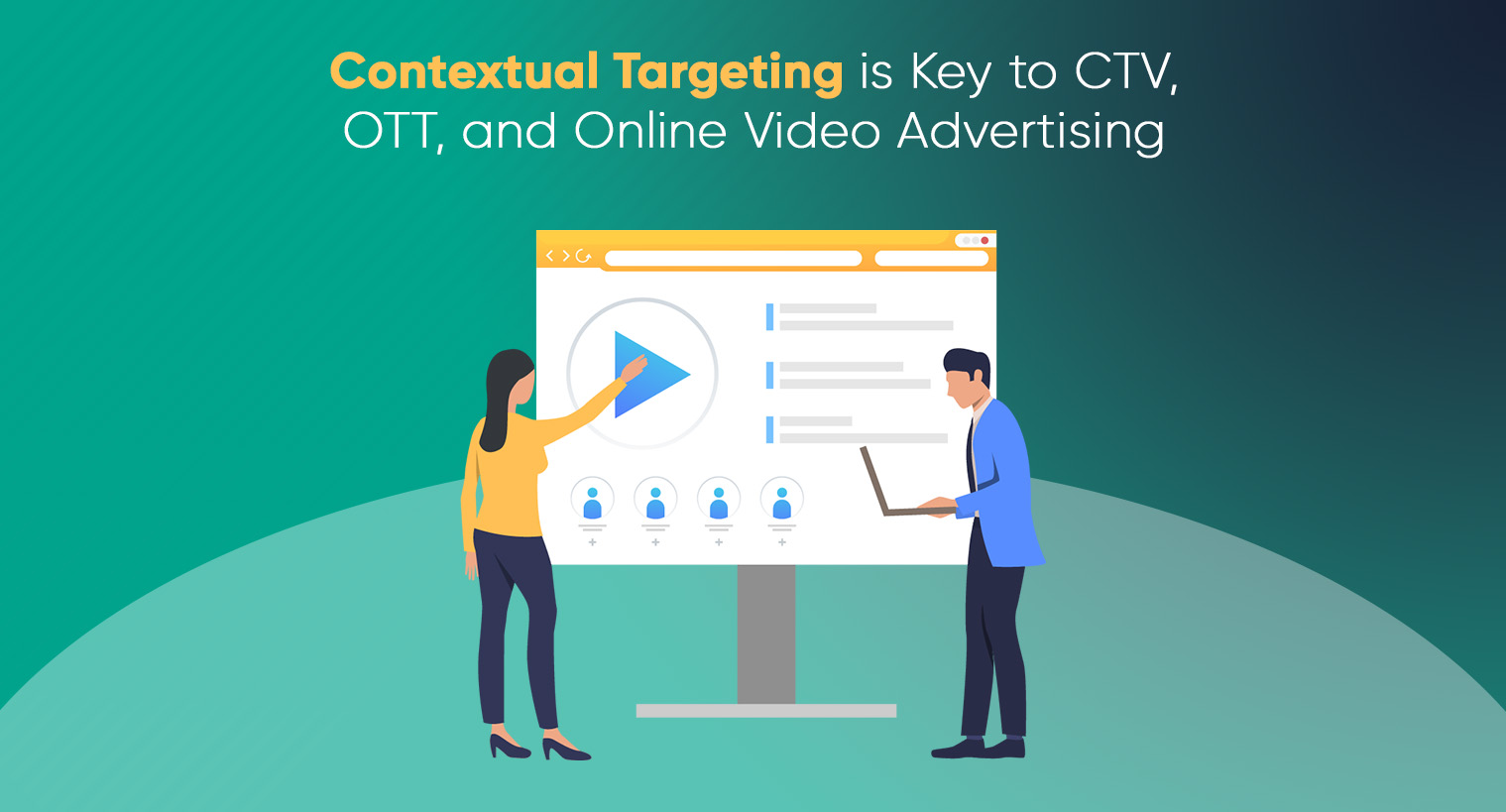
According to an eMarketer report, incremental spending on programmatic connected TV (CTV), and video ads will rise to $2.37 billion in 2021.
This was also confirmed by the IAB’s 2021 Marketplace Outlook Survey Results, which revealed a 21% shift in ad expenditures from linear TV to digital video (CTV).
As we can observe a shift in marketers’ preferences for where to invest their ad expenditures, we can also see a shift in the platforms they use to reach their customers in the right place and at the right time in a brand-safe environment.
The answer to this is contextual advertising. It is capable of comprehending the topic and sentiment of a piece of content. Secondly, it is becoming an even more robust platform to use and comprehend, allowing buyers to reach the relevant audiences through CTV, OTT, and online video.
Rising Usage of CTV and OTT
Without a doubt, Covid-19 is one of the major reasons for an increase in the consumption of CTV and OTT. With almost all the people staying at home, connecting virtually or streaming had to happen. This has also left the advertisers with no option but to shift their strategy for connecting with their audiences in these digital realms.
However, the main challenge for publishers and advertisers, remains, to target their audience during their CTV OTT, or an online video experience.
Contextual advertising makes this possible!
CTV and OTT might be considered similar, but they are a lot different from each other than we think.
CTV, which stands for Connected TV, refers to streaming video on televisions, mobile gaming devices, and applications. PlayStation, Sling TV, Roku are all examples of CTV.
And, over-the-top (OTT) services bypass TV providers and stream on-demand from any device through an app. This can be combined with CTV and is similar to viewing Netflix on your smart TV.
Advertising in CTV and OTT is different and complex from linear TV and this is where the importance of contextual advertising is understood.
Until recently, CTV and OTT advertising relied on IP addresses to provide relevant advertisements. This is similar to how cookies are used, where computers track user activity and serve ads based on what the user clicks on. In the case of CTV and OTT what the audience is watching.
Unlike cookies, contextual advertising protects your audience’s privacy while reaching them through more granular and effective ad placements in CTV and OTT spaces and by recognizing relevant video content that connects with your target demographic.
This strategy allows advertisers to reach more of their target clients while also making their ad purchases more efficient.
The data also contributes to better transparency and performance metrics in the streaming video industry, allowing advertisers to understand where their advertisements are played.
How Does Contextual Targeting Work in CTV, OTT, and Online Video?
With the TV landscape changing, contextual advertising is the up-and-coming strategy offering a data-backed solution to the conventional IP address targeting.
Contextual targeting differs from behavioral targeting because that kind of targeting relies on data indicating a user’s interests, behavior, and demographics. Contextual analysis on the other hand depends on the content itself to align ad campaigns with relevant environments.
Silverpush, an AI contextual advertising company does contextual targeting in CTV, OTT, and online video through its human augmented platforms Mirrors and Parallels.
Mirrors
Mirrors by Silverpush help in context-relevant video level ad targeting using human-enhanced AI technology. It is the world’s first in-video context identification solution, that identifies celebrities, brands, objects, places, actions, on-screen text, and audio for a nuanced targeting at the video level.
During the process, content-aligned ad placement, brand safety, and tailored brand suitability are all guaranteed, along with reaching the largest possible audience.
Parallels
Parallels real-time TV Ad Sync helps brands recapture viewers’ attention with real-time syncing of television ads with digital ads.
It connects with the audience contextually and in real-time by automatically triggering sports ads based on live moments, running contextual creatives, and syncing digital ad placement during TV commercials.
Conclusion
Contextual advertising is the solution for advertisers searching for a targeted and data-backed plan to engage with their target audience.
This strategy does not depend on the IP address and maintains the user privacy by putting ads depending on video content. With this technique, marketers can more precisely contact their target audience where they are by watching video content.
Contextual Approach to Target Digital Advertising
PUBLISH DATE: 07 June 2022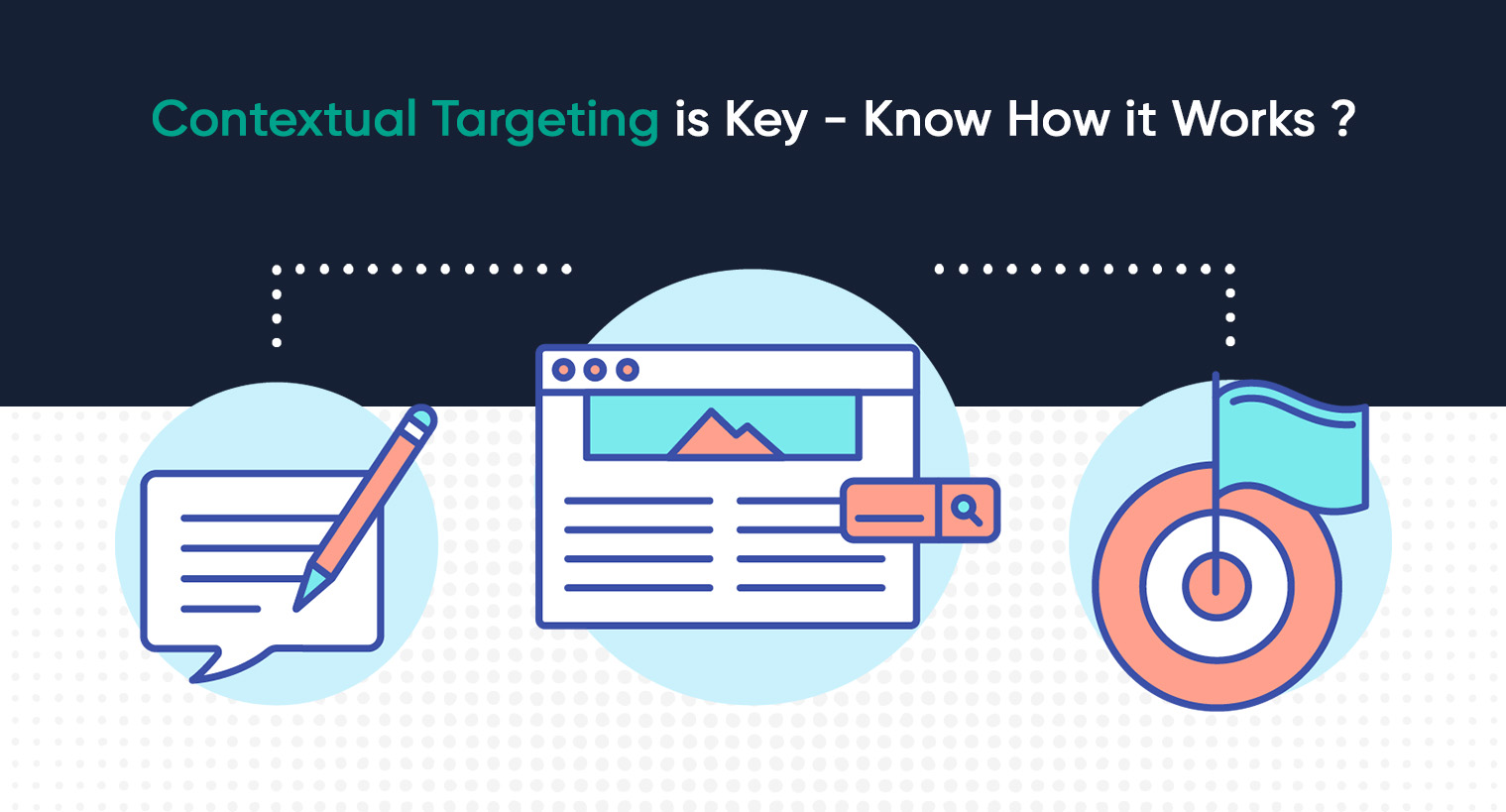
Years before, one of the most spirited topic for debate was whether to put budget against contextual or behavioral targeting. Every marketer wants to approach their target audience at the right time in the right context. This has been achieved by implementing the methods of contextual targeting.
So the question now arises, what is contextual advertising? and why is it on top of mind now?
In this article, we will cover all the aspects of Contextual advertising, starting from what it is to why is it so important to target digital advertising and various contextual advertising services.
What is Contextual Advertising?
Contextual Targeting is the process or practice of displaying ads that are relevant to the website’s content instead of just the user’s data. It is a targeted and automated form of digital advertising. Imagine placing an ad for shoes on a clothing website, or an advertisement for dishware on a recipe site. It’s kind of placing a digital version of a print ad in a highly reputed magazine.
The idea of a contextual approach has been in the market for a really long time. However, it has been gaining more popularity ever since the privacy regulations have become more strict. Moreover, the whole practice of contextual advertising or targeting majorly relies on context and not on user’s personal data.

What are the Different Types of Targeting?
There are various different types of ad targeting present for digital advertising. Let’s check five of the most popular practices of targeting:
- Behavioral Targeting
Behavior targeting is focused more on the actions a user makes before reaching the web page, whether it’s clicking a particular link, product page, or article. One good example of behavioral advertising is retargeting ads.
- Contextual Targeting
In this method, we practice deploying ads based on the website’s content. It works by assuming someone visiting a site and shall be interested in buying other types of utility products as well.
- Search Retargeting
Search retargeting means displaying ads to users when browsing the web as per their keyword search behavior. In simple way, it means that when you set up a search ad campaign, you choose the type of keywords that match your business or products. Let’s take an example to understand this term better. Imagine a company selling women’s shoes also serves ads for searchers looking for “women’s boots” or “black heel evening shoes.”
- Site Retargeting
One of the most common types of retargeting consists of showing ads to the users who visited your site but left without making any purchase or doing an action that showed their interest in your content. This targets brand recognition, this method can bring a high ROI by targeting the bottom part of the funnel.
- Predictive Retargeting
Predictive retargeting uses data collected by behavioral targeting adding a bit of 3rd party data mix and analyzing & predicting buying patterns with the help of artificial intelligence and machine learning. With the help of the AI feature, it can identify behavior patterns, identify products to upsell or cross-sell, and target those audiences which is most likely to convert.
How does Contextual Advertising Work?
Contextual advertising uses artificial intelligence and deep machine learning to analyze content like text, speech, imagery, and geolocation in real-time. Contextual advertising services use tools like Silverpush’s Mirrors to analyze all this data and content to understand if the user will click on your ad. The deep analysis by AI is just like how a human would deploy your ad manually, which ensures that your ad is placed contextually at the relevant place, and is received to your target audience at the right time.
Silverpush’s AI technology Mirrors identifies key contexts such as celebrities, brands, objects, emotions, places, actions, on-screen text, and audio. In addition to this, it also intelligently avoided placing ads against content falling under unsafe/ unsuitable categories like kids, violence, politics, COVID-19, and others.

Reach Target Audience in a Cookieless World
There is no secret that we all love privacy and are very hesitant to share our personal information online. In fact, in a recent survey by Startpage, it is shown that around 72% of Americans are “very concerned” to “extremely concerned” about their online privacy. There are various methods available to target your audience. However, because of new regulations like GDPR, it is going to be difficult for both publishers and advertisers to get consent from users to collect their data for targeting.
[Also Read: Learn About Contextual Targeting and Relevance of Ads]
What are the Pros and Cons of Contextual Targeting in Digital Advertising?
Now, that we have understood the concept of contextual targeting (let’s hope for the best!) shall we now proceed further to see the pros and cons of contextual advertising. It is no doubt it is one of the most effective method of digital advertising but like every coin has two sides, it also has its cons which should also be addressed. These are –
Pros of Contextual Targeting
- Since it relies very little on personal data, contextual targeting is very effective as it compliances with regulations like GDPR with ease. Furthermore, if you don’t collect personal data but only information about the website, then the targeting is outside the terms of the GDPR, and regulation doesn’t apply.
- If done right, contextual targeting can enhance the user experience by adding information to the content in a timely manner. Some studies have shown that contextual targeting may increase purchase intent by 63%.
- Contextual targeting is majorly focused on the interest of the user. For example, contextual advertisements in review sites may increase the number of clicks.
Cons of Contextual Targeting
- You need to be extra mindful when setting up your ad campaign to ensure that the context is not too broad.
- Frequency capping can be an issue.
What are the Future Trends of Contextual Advertising?
Contextual advertising may have been around for a long time but nothing remains static especially when the technology is developing every day. Here, we have mentioned some of the top trends in contextual advertising that you can look out for in the future.
Advancement in relevant software
In order to improve the relevance of targeted ads, developers are trying to improve the need to just insert a JavaScript code into the webpage.
In-text video contextual advertising methods
There are some new technologies emerging in the digital market that allow placing in-video text advertisements on YouTube. It can scan the video for content and display ads based on it.
In-game contextual ads
For some time, developers are trying their best to insert contextual advertising in video games. If an ad appears in the middle of a game it can become very annoying for the gamers. Thus, inserting an ad before or after a game is much more effective and less disruptive for the gamer. With app developers who are trying to monetize their applications, thus developers are trying to find a way to integrate contextual advertising without interfering with the gaming experience.
FAQs on Contextual Approach to Targeting Digital Advertising
Ques. What is Contextual Targeting in digital marketing?
Ans. It is the practice of displaying ads based on a website’s content rather than user’s data. Thus, it reaches the target audience in the relevant context at the relevant time. With the help of contextual advertising, ad placements are viewed as helpful rather than intrusive to the user’s experience. Thus, Contextual Targeting is Key for future digital advertising and trends.
Ques. What is an example of contextual targeting?
Ans. One example of contextual advertising is a shoe brand that could display an ad for sports shoes in a news article about triathlons or on a forum for running/marathons. Another example could be a flour brand that could display its ads on a website which is dedicated to baking or recipes.
Ques. What is contextual targeting in Google Ads?
Ans. Contextual targeting is a practice of personalized advertising that enables your Google PPC ads to appear on relevant websites. In order to get started, you need to input keywords or topics and then set a campaign to show ads on the Display Network.







